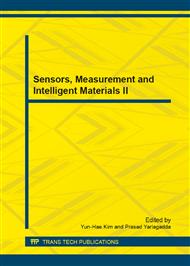[1]
Kim C T, Linsenmeyer T A, Kim H. Bladder volume measurement with electrical impedance analysis in spinal cord-injured patients1. American Journal of Physical Medicine & Rehabilitation, 1998, 77(6): 498-502.
DOI: 10.1097/00002060-199811000-00009
Google Scholar
[2]
Abbey J C, Close L. Electrical impedance measurement of urinary bladder fullness. The Journal of Microwave Power, 1983, 18(3): 305–309.
DOI: 10.1080/16070658.1983.11689335
Google Scholar
[3]
Kodama H, Hieda I, Kuchinomachi Y. Non-invasive ultrasonic urination sensor for ambulatory patient support. Methods of Information in Medicine, 1994, 33(1): 97-100.
DOI: 10.1055/s-0038-1634979
Google Scholar
[4]
Athwal B S, Berkley K J, Hussain I. Brain responses to changes in bladder volume and urge to void in healthy men. Brain. 2001, 124(2): 369-377.
DOI: 10.1093/brain/124.2.369
Google Scholar
[5]
Mudraya I S, Revenku S V, Nesterov A V. Bioimpedance harmonic analysis as a tool to simultaneously assess circulation and nervous control. Physiological Measurement, 2011, 32(7): 959-976.
DOI: 10.1088/0967-3334/32/7/s17
Google Scholar
[6]
Waltz F, Frederick M. Bladder volume sensing by resistance measurement. Ieee Transactions on Biomedical Engineering, 1971, 18(1): 42-46.
Google Scholar
[7]
Wachter S G, Heeringa R, Koeveringe G A. On the nature of bladder sensation: the concept of sensory modulation. Neurourology and urodynamics. 2011, 30(7): 1220-1226.
DOI: 10.1002/nau.21038
Google Scholar
[8]
Drinkhill M J, Mary D A S A G, Ramadan M R M. The effect of distension of the urinaru bladder on activity in efferent renal fibres in anaesthetized dogs. Journal of Physiology, 1989, 409(2): 357-369.
DOI: 10.1113/jphysiol.1989.sp017502
Google Scholar
[9]
Lynne C W. Organization of sympathetic responses to distension of urinary bladder. Regulatory, Integrative and Comparative Physiology, 1985, 248(2): 236-240.
DOI: 10.1152/ajpregu.1985.248.2.r236
Google Scholar
[10]
Bertil F M, Gert Holstege. The central nervous system control of micturition in cats and humans. Behavioural Brain Research, 1998, 92(2): 119-125.
DOI: 10.1016/s0166-4328(97)00184-8
Google Scholar
[11]
Derek Griffiths. Imaging bladder sensations. Neurourology and Urodynamics, 2007, 26(2): 899-903.
DOI: 10.1002/nau.20488
Google Scholar
[12]
Heeringa R, Koeveringe G A, Kerrebroech P E V. Degree of urge, perception of bladder fullness and bladder volume: how are they related? The Journal of Urology, 2011, 186(4): 1352-1357.
DOI: 10.1016/j.juro.2011.05.050
Google Scholar
[13]
Heeringa R, Koeveringe, GA, Kerrebroeck P.E.V. Forced diuresis as a tool for the non-invasive evaluation of bladder sensation. Neurourology and Urodynamics, 2010, 29: 909.
Google Scholar
[14]
Gill B C, Fletter P C, Zaszczurynski P J. Feasibility of fluid volume conductance to assess bladder volume. Neurourology and Urodynamics, 2008, 27(6): 525-531.
DOI: 10.1002/nau.20551
Google Scholar
[15]
Liao W C, Jaw F S. A noninvasive evaluation of autonomic nervous system dysfunction in women with an overactive bladder. International Journal of Gynecology and Obstetrics, 2010, 110(1): 12-17.
DOI: 10.1016/j.ijgo.2010.03.007
Google Scholar
[16]
Ness T J, Richter H, Varner R. A psychophysical study of discomfort produced by repeated filling of the urinary bladder. Pain, 1998, 76(1-2): 61-69.
DOI: 10.1016/s0304-3959(98)00023-2
Google Scholar
[17]
Wachter S D, Wyndaele J J. Frequency volume charts: a tool to evaluate bladder sensation. Neurourology and Urodynamics, 2003, 22(7): 638-642.
DOI: 10.1002/nau.10160
Google Scholar
[18]
Boyle J, Bidargaddi N, Sarela A. Automatic detection of respiration rate from ambulatory single-lead ECG. Ieee Transaction Information Technology Biomedicine, 2009, 13(6): 890–896.
DOI: 10.1109/titb.2009.2031239
Google Scholar
[19]
Bristow S E, Neal D E. Ambulatory urodynamics. British Journal of Urology, 1996, 77(3): 272-274.
Google Scholar
[20]
Willemsen G H, De J, Klaver C H. Ambulatory monitoring of the impedance cardiogram. Psychophysiology, 1996, 33(2): 184-193.
DOI: 10.1111/j.1469-8986.1996.tb02122.x
Google Scholar
[21]
Griffiths C J, Assi M S, Styles R A. Urological neurology and urodynamics. The Journal of Urology, 1989, 142(1): 780-784.
Google Scholar
[22]
Kechtkar A, Mesbahi A, Mehnati P. The effect of bladder volume changes on the measured electrical impedance of the urothelium. International Journal of Biomedical Engineering and Technology, 2008, 1(3): 287-292.
DOI: 10.1504/ijbet.2008.016962
Google Scholar
[23]
Robertson A S, Griffiths C J, Ramsden P D. Bladder function in healthy volunteers: ambulatory monitoring and conventional urodynamic studies. British Journal of Urology, 1994, 73(3): 242-249.
DOI: 10.1111/j.1464-410x.1994.tb07512.x
Google Scholar
[24]
Provost B, Sawan M. Proposed new bladder volume monitoring device based on impedance measurement. Journal of Medical and Biological Engineering, 1997, 35(6): 691–694.
DOI: 10.1007/bf02510979
Google Scholar


